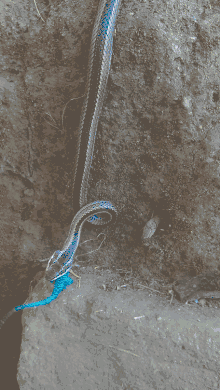Philodryas chamissonis
Philodryas chamissonis, commonly known as the Chilean green racer and the Chilean long-tailed snake, is a species of moderately venomous opisthoglyphous (rear-fanged) snake in the family Colubridae. The species is endemic to Chile.[4]
| Philodryas chamissonis | |
|---|---|
 | |
| Scientific classification | |
| Domain: | Eukaryota |
| Kingdom: | Animalia |
| Phylum: | Chordata |
| Class: | Reptilia |
| Order: | Squamata |
| Suborder: | Serpentes |
| Family: | Colubridae |
| Genus: | Philodryas |
| Species: | P. chamissonis |
| Binomial name | |
| Philodryas chamissonis (Wiegmann, 1834) | |
| Synonyms | |
| |
Etymology
The specific name, chamissonis, is in honor of German botanist and poet Adelbert von Chamisso.[2][5]
Description
Usually, P. chamissonis is gray, with black and white longitudinal stripes on the body. It is a medium-sized snake, which usually reaches 1.4 m (4.6 ft) in total length (including tail).
The length of the tail is 25-28.5 % of the total length. There are 8 upper labials, the 4th and 5th entering the eye. The smooth dorsal scales are arranged in 19 rows at midbody. Ventrals 179-225; anal plate divided; subcaudals 100-122.[6]
Habitat
P. chamissonis lives in a large variety of habitats, at altitudes from sea level to 2,300 m (7,500 ft).[1]
Diet

The diet of P. chamissonis is mainly composed of little rodents, birds, amphibians, and other smaller reptiles.[1] For example, it especially preys upon lizards of the genus Liolaemus.[1]
Venom
Because P. chamissonis is rarely found, bites by it are uncommon. However, its bite is painful and causes extensive swelling.[7]
References
- Avilés R; Garin C; Nunez J; Ortiz JC; Sallaberry N; Tala C; Victoriano P; Vidal M (2016). "Philodryas chamissonis ". The IUCN Red List of Threatened Species. IUCN. 2016: e.T16985A69941244. doi:10.2305/IUCN.UK.2016-1.RLTS.T16985A69941244.en. Retrieved 15 January 2018.
- Species Philodryas chamissonis at The Reptile Database www.reptile-database.org.
- Sallaberry-Pincheira N, Garin CF, González-Acuña D, Sallaberry MA, Vianna JA (2011). "Genetic Divergence of Chilean long-tailed snake (Philodryas chamissonis) across latitudes: conservation threats for different lineages". Diversity and Distribution 17: 152-162.
- "Philodryas chamissonis ". ITIS (Integrated Taxonomic Information System). www.itis.gov.
- Beolens, Bo; Watkins, Michael; Grayson, Michael (2011). The Eponym Dictionary of Reptiles. Baltimore: Johns Hopkins University Press. xiii + 296 pp. ISBN 978-1-4214-0135-5. (Philodryas chamissonis, p. 51).
- Boulenger GA (1894). Catalogue of the Snakes in the British Museum (Natural History). Volume II., Containing the Conclusion of the Colubridæ Aglyphæ. London: Trustees of the British Museum (Natural History). (Taylor and Francis, printers). xi + 382 pp. + Plates I-XX. (Dromicus chamissonis, pp. 119-120).
- Neira P, Jofré L, Oschilewski D, Subercaseaux B, Muñoz N (2007). "Mordedura por Philodryas chamissonis. Presentación de un caso y revisión de la literatura (Snake bite by Philodryas chamissonis: a case presentation and literature review)". Revista chilena de infectología 24 (3): 236-241. (in Spanish).
Further reading
- Freiberg M (1982). Snakes of South America. Hong Kong: T.F.H. Publications. 189 pp. ISBN 0-87666-912-7. (Dromicus chamissonis, p. 95).
- Wiegmann AFA (1835). "Beiträge zur Zoologie, Gesammelt auf einer Reise um die Erde. Siebente Abhandlung. Amphibien ". Nova Acta Physico-Medica Academiae Caesareae Leopoldino-Carolinae Naturae Curiosorum (Wrocław and Bonn) 17: 185-268 + Plates XIII-XXII. (Coronella chamissonis, new species, pp. 246–250 + Plate XIX). (in German and Latin).
